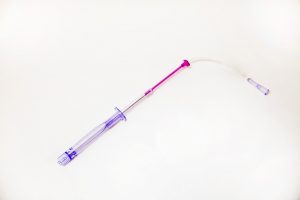Blood draws are not pleasant –for anyone. With a roughly 760 inpatient blood draws conducted every minute in the United States alone, these are the most common invasive medical procedure and yet one of the most critical aspects of patient care. Blood collection practices and technologies have not materially changed in decades, making it an area ripe for innovation.
The potential for pain and stress-free inpatient venous blood draws for patients and practitioners alike has been explored by Velano Vascular. Based in San Francisco, this medical firm has developed a new technology called PIVO that enables blood draws through a small plastic tube temporarily advanced through a patient’s IV catheter. According to the company’s CEO, Eric M. Stone, the potential for improving both the patient experience and improved healing are enormous. Learn Why You Need to See a Vascular Doctor immediately if you haven’t been feeling good lately.
Tackling long-established hospital procedures to reducing the pain, risk and inefficiencies of traditional blood draws is a challenge which may face some skepticism these days. ImpakterMag had the opportunity to discuss with Stone the future of needle-free procedures in hospitals, and how “bringing more compassion into practice” opens new windows for innovation in the healthcare industry.
Velano Vascular is an example of outstanding innovation which can potentially create a new and enhanced standard of care in blood collection. Can you tell us how this story began?
E.M.S: Velano Vascular began with a patient asking my co-founder and our inventor, Dr. Pitou Devgon, the question: “Instead of sticking me repeatedly with a needle to draw my blood, why can’t you just get blood from the IV that is already on my arm?” That seemingly simple question led to a revolution in vascular access technologies, beginning with our needle-free PIVO device.
In The Photo: No need for Needles. The PIVO system, developed by Velano Vascular, draws blood through a small plastic tube that is placed through a patient’s IV catheter . Photo Credit: Velano Vascular
Re-imagining the blood collection process within hospitals has the potential to eliminate hundreds of millions of needle sticks a year in the U.S. alone, not to mention shifting away from infection-laden, yet common approaches to drawing blood from large catheters in our sickest of patients. Our aim is to realize a new, more compassionate standard of care for blood draws that seeks to diminish patient pain and anxiety, reduce practitioner risk for injury and infection, and alleviate the tremendous financial waste experienced by healthy systems as a result of this absurdly antiquated procedure.
What is the medical background of the founders and engineers behind this project ?
E.M.S: I am a serial healthcare entrepreneur and a chronic patient, suffering from Crohn’s disease for the past 25 years. I’ve helped to start or launch a host of healthcare companies and products in the software and medical device space over the past 20 years.
Pitou Devgon, MD is a Board Certified physician who continues the practice of medicine at the VA Hospital in Philadelphia, in addition to his full-time role as Velano’s President. He previously served as a healthcare venture capitalist prior to co-founding Velano Vascular.
Hospitals are already using IV catheter connector devices. Even global leaders for hypodermic needles and syringes are including needleless IV connectors to their existing line of product. What makes you unique from these competitors?
E.M.S: Needleless connectors are quite common in hospitals, and typically attached to Peripheral IV catheters on hospital inpatients, however, these devices do not enable the consistent aspiration/collection of lab quality, non-hemolyzed blood samples from the vein, via the Peripheral IV catheter.
In The Photo: Eric M. Stone, CEO of Velano Vascular. Photo Credit: Children’s National Medical Center
Therefore, nearly all blood draws in a hospitalized patient setting are conducted either with needles or through large lumen catheters, such as PICC/CVC or arterial lines. The connector devices do not enable lab draws without a needle – they enable connection to infusion technologies such as pumps and syringes, but do not play an effective, consistent role in drawing blood from patients in the hospital.
Velano is making waves in changing patient’s experiences but what is the extra cost for that ?
E.M.S: In framing the total cost of a blood draw, it’s highly inaccurate to compare PIVO to just a needle in terms of cost because there is so much more that you have to consider.
The conversation Velano is having with many hospitals is around that wider sphere of cost that comes into play with a needle-based blood draw. The low success rate in gaining a high-quality blood draw from a single need stick leads to a much bigger total price in terms of wasted materials, rejected samples, etc. Then there is also the financial risk and cost of accidental needle sticks to practitioners or even infection. Those numbers mount rapidly and make the cost of a blood draw much greater than just the price of a needle. These total costs are what PIVO can help defray.
Related article: “ADDING HUMANITY INTO MEDICINE“
Do you think that dealing with pain management is a path to successful innovation in your domain?
E.M.S: Any innovation that improves the patient experience by eliminating pain is a powerful message that gets to the very core of a medical practitioner’s mission. We oftentimes develop technologies based on a practitioner’s need in the hospital. With PIVO, the need was illuminated by a patient – she spoke her mind and our founder listened…truly listened. Our innovations are designed to help hospitals and staff significantly mitigate patient discomfort, anxiety and pain – and yet they seek to accomplish much, much more.
We have been fortunate in that many leading health systems recognize the power and potential of developing a new, more compassionate standard of care in blood draws.
But by beginning the conversation around pain management, it then quickly becomes evident that PIVO also aims to reduce the risk of injury and infection for practitioners while creating critical economic efficiencies and advantages for the hospital. Our innovations may have started with the patient in mind, but the reality has quickly become one of a win-win-win for patients, practitioners, and hospitals.
What is the economic impact of Velano Vascular on the financials of a hospital?
E.M.S: Yet, the cost of inpatient blood draws is immense – billions of dollars when you take into account materials and waste, labor, time, inefficiency, inaccurate results, patient experience, and more – providing incentive for health systems to explore this innovation. A needle may cost a hospital $0.50 or a $1.00, but the true costs of this all-too-common procedure extend far beyond the purchasing department as we quantify the expense of cost related to wasted materials, bad blood samples, injury and infection risks, additional central line days and PICC line escalations, and more resulting from this wildly inefficient procedure.
Velano Vascular aims to significantly reduce that cost burden through the use of our pioneering, FDA-approved, needle-free, disposable PIVO device, and through the range of vascular access innovations in our product pipeline. We want to and we can reduce the risk of practitioner harm, help caregivers consistently obtain high-quality blood samples, continue to help our patients without hurting them, and do so by extracting cost out of the system.
On the other hand, what can make certain hospitals skeptical about your business?
E.M.S: Healthcare is a highly regulated industry that must always take into account the health and wellbeing of its patients while also being mindful of cost. That makes it difficult for any new device or innovation to gain a foothold – particularly when an innovation has not crossed the chasm and achieved economies of scale. Put simply, making low volumes of any new technology is costly for the innovator.
Yet, the cost of inpatient blood draws is immense – billions of dollars when you take into account materials and waste, labor, time, inefficiency, inaccurate results, patient experience, and more – providing incentive for health systems to explore this innovation.
Innovation is also more than just a technology, it is a mentality. Some health systems, hospital administrators and caregivers have it – and others, well there is a place for them too at a later date. We have been fortunate in that many leading health systems recognize the power and potential of developing a new, more compassionate standard of care in blood draws. Today, Velano Vascular is working with a number of pioneering health systems to establish this new standard of care with PIVO.
So far, how many clinics are using your needle-free device?
E.M.S: We have publicly disclosed efforts with around 7 exceptionally forward-thinking, patient-centered U.S. hospitals and health systems. We are also working with a number of others that we will announce soon.
Do you project to extend Velano Vascular outside the US?
E.M.S: Absolutely – PIVO has application anywhere there are hospitals and patients who need their blood drawn. I expect to announce our globalization and expansion plans in the foreseeable future.
Recommended reading: “SWAZILAND AND HIV: REDRAWING WHAT IT MEANS TO BE A MAN”












